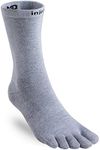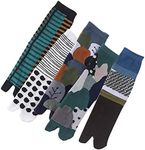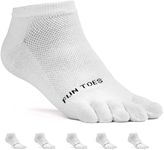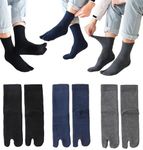Buying Guide for the Best Toe Socks
Choosing the right toe socks can make a big difference in comfort, foot health, and performance, whether you’re wearing them for everyday use, sports, or specific activities like yoga. Toe socks are designed to separate each toe, which can help reduce friction, prevent blisters, and promote natural toe movement. When shopping for toe socks, it’s important to consider a few key features to ensure you get the best fit and function for your needs.MaterialMaterial refers to the fabric or blend used to make the socks. This is important because it affects comfort, breathability, moisture management, and durability. Common materials include cotton, wool, synthetic fibers like polyester or nylon, and blends. Cotton is soft and breathable but may not wick moisture as well as synthetics. Wool is great for temperature regulation and odor control, making it ideal for colder weather or long wear. Synthetics are often used for athletic toe socks because they dry quickly and manage sweat effectively. If you want everyday comfort, cotton or blends are a good choice. For sports or hiking, look for moisture-wicking synthetics or wool.
ThicknessThickness describes how thick or thin the socks are, which affects warmth, cushioning, and how they fit in your shoes. Thin toe socks are lightweight and fit well in snug shoes, making them good for running or casual wear in warm weather. Medium thickness offers a balance of comfort and cushioning, suitable for most daily activities. Thick toe socks provide extra padding and warmth, ideal for hiking, cold weather, or if you need more cushioning. Choose the thickness based on your activity and the type of shoes you’ll wear them with.
Toe SeparationToe separation is how well the socks keep each toe apart. This is important for reducing friction between toes, preventing blisters, and allowing natural toe movement. Some toe socks have snug, well-defined toe pockets, while others are looser. If you want maximum blister prevention or do activities that require toe flexibility (like yoga or running), look for socks with well-fitted, separate toe compartments. For general comfort, a less pronounced separation may be fine.
LengthLength refers to how high the socks go on your leg. Options include no-show, ankle, crew, and knee-high. No-show and ankle lengths are good for low-cut shoes and warm weather. Crew length offers more coverage and is versatile for most activities. Knee-high socks provide extra warmth and protection, often used for hiking or colder climates. Pick the length based on your shoe style, activity, and climate.
Grip or Non-Slip FeaturesSome toe socks have grip patterns or non-slip soles, especially those designed for yoga, pilates, or indoor activities. This feature helps prevent slipping on smooth surfaces, providing stability and safety. If you plan to use toe socks for activities on slick floors, look for socks with silicone or rubber grips on the bottom. For regular use in shoes, this feature is less important.
Seam ConstructionSeam construction refers to how the socks are stitched, especially around the toes. Flat or seamless designs reduce irritation and pressure points, which is important for comfort, especially if you have sensitive skin or plan to wear the socks for long periods. If you’re prone to blisters or discomfort from seams, look for toe socks labeled as seamless or with flat seams.



















